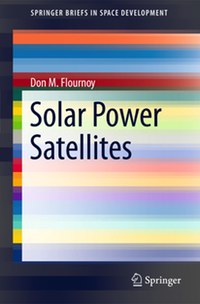Review: Solar Power Satellitesby Paul Jaffe
|
| Flournoy’s book constitutes an excellent and cogent primer for the fascinating and wide-ranging subject of solar power satellites. |
The book is not perfect, though. Perhaps one shortfall of the book is Flournoy’s frequent citation of authority figures to make various points. Space industry veterans and university professors are generally qualified experts, but reliance on their viewpoints is not a substitute for quantitative or critical analysis. In addition, the chapter regarding economic analysis is fairly cursory and does not sport the extensive collection of relevant references featured at the end of most other chapters. Likewise, the military and niche power markets are discussed only briefly, despite their offering more promise as a source of demand for higher cost power than in the utility grid case. In general, for the examination of the hurdles and problems for space solar power, the case of photovoltaic power generation and microwave power beaming is assumed, though laser power beaming does receive some attention. Although there are several thoughtful skeptical analyses of the space solar power concept, they are left largely ignored.
A particular strength of the book is the treatment of the state of existing international efforts. In providing a window into the work of the Chinese and others on solar power satellites, Flournoy offers a glimpse not only of the scale and seriousness with which major space powers are examining the topic, but also of the secondary and tertiary social and economic benefits of pursuing the development of a space-based solar power system.
Overall, there likely does not currently exist a more comprehensive, concise, and readable introduction and summary of the solar power satellite concept, its challenges, prospects, and history. Flournoy’s book is most welcome and constitutes an excellent and cogent primer for the fascinating and wide-ranging subject of solar power satellites.
